#Food Ingredients South America
Explore tagged Tumblr posts
Text
I have many thoughts now on food an colonialism that I need to write down but I am at work and on mobile
#Like at what point#Does a food become part of a specific culture#Bc so much is shared#So many ingredients came from somewhere else#Potatos from south America#Noodles from China#Spices from India#Not to mention how most southern American food#Was created by slaves#There are so many thoughts here#That I need to navigate
10 notes
·
View notes
Text
Writing Reference: Symbolism of Food

We need food to live, so it comes as no surprise that we have accorded many ingredients with "magical powers".
Indeed, some of the things we eat every day carry both constituent elements and meanings which go far beyond mere nutrition.
Below is a list of some foods, real and mythical, which have become symbols in themselves.
AMBROSIA
For the Greeks, ambrosia was the food of the Gods.
Given that it conferred immortality, the deities on Mount Olympus guarded it jealously.
As well as ensuring eternal life, ambrosia could be used as an ointment that could heal any wound.
However, for a mortal, eating ambrosia was a big mistake.
Example: The story of Tantalus. He was invited to eat with the Gods, and so, presuming that he was accepted as one of them, he ate ambrosia. In the tradition of all good dinner party guests, he decided to return the favor and invited the Gods round to his place. Deciding somewhat sycophantically that they should feast upon all the good things that they had given him, he served up the flesh of his own children, and was banished to Hades.

CHOCOLATE
Long before the Western discovery of the Americas, the natives of Brazil, Mexico, the West Indies, and South America used the seeds of the chocolate tree to make a stimulating drink. These bean-like seeds were cacahuatl, or cocoa.
Primarily symbolic of love, chocolate is a sensual food with aphrodisiac properties that are due, in part, to association.
However, its melting point is the same temperature as blood, a very satisfying sensation.
The botanical name of the plant gives a clue as to its sacred status. Theobroma cacao means “food of the Gods,” from the Greek “Theo,” meaning God and “Broma,” meaning food.
The beans were so highly valued that the Mayans used them as currency.
Possibly the world’s first chocoholic, their ruler Montezuma was completely addicted to the beans.
He drank them infused in cold water with no seasoning. He served this sacred drink in goblets of beaten gold, and at the coronation of Montezuma II in 1502 a concoction of chocolate and psilocybin mushrooms was served to the guests. This must have been a heady mixture.
Cortés cultivated the plant primarily because of its reputation as an aphrodisiac; this secret was divulged by one of the nineteen young women given to him by Montezuma as a tribute. Perhaps the 2000 chocolate trees that he consequently planted were testimony to the efficacy of the beans in keeping the ladies satisfied.
By 1550, chocolate factories were operating in Lisbon, Genoa, Marseilles, and other European cities. The recipes became more and more refined.
Catherine de Medici slowed down the progress of chocolate for a while because it was so good that she wanted it all to herself.
However, although the Church tried to ban many of the foodstuffs that had been discovered in the New World, especially those that were considered as stimulants, their advice was largely ignored and it is possible that this disapproval increased the popularity of this illicit substance.
Neither Catherine nor all the forces of the Church could stop the world becoming chocolate coated.
Today, the form of chocolate has changed so much that Montezuma would probably find it unrecognizable, both in taste and form. However, it is still unrivalled as a token and symbol of love.

HONEY
Legislation decrees that all packaged food carry a “best before” date, but this seems to be particularly unnecessary in the case of honey, since jars of the stuff found in the tombs of Egyptian kings of several thousand years ago has proved to be perfectly edible even now.
It could well be because honey is so long lasting, and because it is used as a preservative, that it is a symbol of immortality and is used in funerary rites.
The bees that make the honey have their place in the realms of magical creatures accorded with supernatural powers, but more of that in the Fauna section.
The Promised Land is said to “flow with milk and honey” as being the very best that the Gods can offer.
The sweetness of honey is believed to confer gifts of learning and poetry.
We’ll never know if the story that Pythagoras existed on honey alone is true, but the fact that the rumor exists is in accord with his God-like status.
As well as being edible and fermentable, honey has healing and antiseptic qualities, and a dollop of honey smeared onto a wound will soon draw out any impurities and speed the healing process.
Honey is said to be an aphrodisiac and to encourage fertility and virility, wealth and abundance, and is a symbol of the Sun, partly because of the flowers from which it is made but also because of its color.
MEAD
Like honey, mead also carries the gift of immortality.
The Celts believed it was the favored drink of the Gods in the Otherworld.
It is a sacred drink in Africa, too, where it is believed that drinking the stuff will make you more knowledgeable.
It is very simple to make—it’s simply honey mixed with water and allowed to ferment—and this process of fermentation is akin to a magical process in itself, which is akin to transmutation in alchemy.

MILK
Given that milk is the first food, it’s not surprising that it is associated with many stories of the Creation, and is a symbol of divinity.
Amrita, or soma, the absolute nectar of life for Hindus and the equivalent of ambrosia, was created as a cosmic sea of milk was churned.
The curds that were created by this epic stirring formed the Earth, the Universe, and the stars.
Along with honey, there is an abundance of milk in the Promised Land, and Indian myths tell of a magical milk tree in Heaven.
Because of its color and its association with the feminine, milk is a symbol of the Moon.
The main food source for milk for us human beings (once we’re weaned) is the cow.
The cow is sacred in India because during times of famine it made far more sense to keep the animal alive for its milk rather than slaughter and eat it purely for its meat, so all parts of the cow are accorded sacred status and are ruled over by one or other of the Gods or Goddesses.
In the hidden symbolic language of alchemy, the Philosopher’s Stone is sometimes called the Virgin’s Milk.
NECTAR
Nectar is often referred to as ambrosia, but has secrets of its own to tell.
Flowers create it, and its scent attracts the bees, which then transform the nectar into honey.
Seemingly insignificant, nectar is nevertheless a very magical ingredient, created from flowers, sunshine, and bees working together in a collective consciousness known as the “hive mind” in an environment which itself is constructed from one of the key shapes in sacred geometry, the hexagon.
SOMA
Like the Greek Olympians, the Indian deities had a type of food, like ambrosia, that ensured their immortality.
This was soma, or amrita. Whereas dire consequences befell any mortal that dared to partake of ambrosia, the Indian Gods were more generous with their soma, and any mortal that ate it was immediately given immortality and access to Heaven.
The ancient Indian Vedic scriptures, the Ramayana, tell the story of Rama, an epic hero, the perfect man:
Rama was born after his father was visited by an angel.
This angel brought with him some magical food.
Eating this soma meant that Rama’s father was able to sire offspring that were the human incarnations of the God, Vishnu.

WINE
The symbolic meanings of wine are generally attached to the red variety; it seems that a nice dry white or a sweet rosé carries no hidden mystery.
The red color means that wine is often linked to blood, particularly since the wine is the “blood” of the grape.
Because it looks like blood, wine is often used in rituals where blood would otherwise be called for, and because ceremonial wine is often drunk from a shared chalice, it is seen, like bread, as a unifying principle.
Wine is male, and bread is female.
As a partner to bread in the ritual of the Eucharist, the consecrated wine is transformed into the blood of the Christ, a reminder of both sacrifice and immortal life, and it’s this transformative power that accords wine with much of its mystique.
When the water is turned into wine in the story of the Marriage at Cana, what is really being shown here is the transformation of the mundane into the magical, the Earthly into the Heavenly.
It is this magical process of fermentation at work that explains why wine is associated with Bacchus/Dionysus, and the intoxicating power of wine is symbolic of divine possession.
The phrase, “In vino veritas” links wine to the truth and is a reminder that those intoxicated by perhaps a little too much of that nice claret will be more likely to speak the truth than most, which can be good or bad, depending on the circumstances.
Source ⚜ Writing Notes & References
#writing reference#symbols#food#writeblr#spilled ink#dark academia#light academia#studyblr#literature#mythology#writers on tumblr#writing prompt#poetry#poets on tumblr#creative writing#writing inspiration#writing inspo#writing ideas#writing resources
129 notes
·
View notes
Note
The debate that's older than I am.
That being; "Eowyn's cooking is awful enough to kill grown men, or is Rohan's cultural food that strange to foreners?"
So, I'm curious what you think a regular meal is like in Edoras for one. I live in Midwestern America, and a staple is plain but calorie rich food to keep you full longer and to deal with the cold better, and sometimes I wonder if Rohan could be the same way. Of course, making outsiders not used to such a "strange" diet.
But it could also go the other way that people in Edoras (especially Eowyn) do not know what a nice meal looks like, and will continue to cook horrors for generations to come.
Do you have any thoughts? :).
Ah, the Éowyn stew scene….one that I would have on my short list to “discuss” with Sir Peter if the opportunity ever came to pass!
I think if you accept that scene as canonical, then the only thing you can reasonably infer from it is that Éowyn never learned how to cook. (And why should she? From the time that she was 7, she was living in the king’s own household with only him, Théodred and Éomer as family. They had staff for cooking, and she probably would have been shooed out of the kitchens even if that was a place she wanted to be!)
Anyone who wants to go from there to the idea that Rohirrim food is bad overall or that they’re making things that are so culturally distinct and unusual that their food is off-putting to outsiders is certainly welcome to make that their HC, though I don’t personally see it that way. And I think the books back me up — there are *several* scenes with large groups of people from across Middle Earth taking meals in Rohan, and nowhere in any of them is even a single whisper of a hint that there’s anything strange or unpleasant about the Rohirrim food.
Geographically speaking, a lot of Rohan does seem like the American midwest or central plains — lots of open, grassy land, a full four seasons of weather, landlocked but with rivers. They had wild boar and probably deer and rabbits, since those were in the surrounding lands. They raised “herds,” which probably meant horses but could have also been cows. They had lots of farms — Saruman’s troops burned a bunch on their way to Helm’s Deep! — and could have grown all kinds of grains and produce that are appropriate for that climate (Aragorn says parts of Rohan are only 60 leagues south of the Southfarthing, though much further east, so perhaps their growing options wouldn’t have been all that different from the Shire, at least outside of the mountainous areas!). They could have fished in the rivers.
So they’d have had access to lots of different types of ingredients, none of which are especially unusual either here or in-universe. And I don’t see any reason why the cooks of Rohan would be uniquely inept or incapable of using those ingredients to make things that were good! I happen to agree with your characterization — a lot of Rohan isn’t *fancy* or *cosmopolitan* so they’re not making really elaborate, complicated cuisine with a capital C, but they’d have things that were hearty and filling and would keep you on your feet for long days of physical work. And that doesn’t have to mean lacking in flavor or skill! And then, of course, there are also plenty of royals and nobility in Rohan, and they could have easily had fancier, more sophisticated food since they’d have resources to get the best ingredients and full-time staff to handle just food preparation.
So that’s my thought! It seems like you and I are probably on the same page here, though certainly let me know if you’ve got other ideas and opinions — I am *always* happy to hear them! And thanks for asking!
38 notes
·
View notes
Text
I want to express my frustration because... im trying to write some time travel Merthur fanfic as one does...
and I keep hitting my head against the same wall. Because just in case you didn't know England SUCKED before imperialism and colonialism.
Not that that made it better but, the English isles didn't have a variety of fruits or vegetables, the did have meat and fish and salt I think, but no sugar or way of producing it but honey if I remember correctly.
And admittedly climate change is a pain in the ass, but in medieval times the winters probably consisted in huge blizzards and freezing for 4 months.
They didn't even had tea!!!
All the good stuff its because of colonialism which is horrible for the world but whatever.
Im trying so hard to ignore this facts... to be free and write about silly angsty boys but I needed someone to know how difficult it is.
Because Merlin having lived in a 21 century would have spent since the 16th drinking bloody tea, and now he is back in time and doesn't have tea, doesn't even have sugar, it's a pain in the ass to get milk, and he can't even get his favorites foods because the fruits and vegetables aren't even evolved yet.
BECAUSE YES! All of the greens have suffered a tremendous amount of change because of selective farming!! so even if there were apples back there, they probably wasn't the same apple, probably weren't even half as sweet as they are now a days!
Same with animals, and plants. Many of the species have gone extinct but they existed back then. And im dying for a chance to bring this into the fic, to prove just how difficult the transition it's, but a the same time, it doesn't matter right? not really.
bUT I NEEDED TO VENT A LITTLE SO thank you for listening to my rant.
Also im not even a history girly, im an art babe, so all of this I know by logic and assumptions from my art history clases, and my hyper fixation, so obviously take everything with a grain of salt.
((It's just that I was cooking and I was trying to think which ingredients were available at that time to make the most simple dish but no, there was almost none, no spices, no tomato, I think the had cabbage, and like broccoli because its the same plant, but probably wasn't evolved into all of the different versions we know, they had beans, and lentils I think, the potatoes come from South America, so no potatoes, the had bread but what kind of bread??? sO YEAH, this is my head.. all the time))
#fanfiction#au#idea#merlin emrys#merlin x arthur#merthur#bbc merlin#fanfic#merlin#arthur pendragon#time travel#imagine having tried a kebab#and then going back to the Middle Ages#sorry Merlin but I could not#writing promt#merthur prompt#fic prompt#in the end the solution to this its always magic#magic doesn't need logic#but its still annoying#and funny#Actually#imagine athur eating a tomato for the first time#or like a banana#where does the pomegranate comes from#I need to do research
97 notes
·
View notes
Text

The American English expression "fried chicken" was first recorded in the 1830s, and frequently appears in American cookbooks of the 1860s and 1870s. The origin of fried chicken in the southern states of America has been traced to precedents in Scottish and West African cuisine. Scottish fried chicken was cooked in fat, and West African fried chicken added different seasonings,and was battered and cooked in palm oil. Scottish frying techniques and African seasoning techniques were used in the American South by enslaved Africans

Fried chicken provided some means of an independent economy for enslaved and segregated African-American women, who became noted sellers of poultry (live or cooked) as early as the 1730s.Because of the expensive nature of the ingredients, it was, despite popular belief, a rare dish in the African-American community reserved (as in Africa) for special occasions.When it was introduced to the American South, fried chicken became a common staple. Later, as the slave trade led to Africans being brought to work on southern plantations, the enslaved people who became cooks incorporated seasonings and spices that were absent in traditional Scottish cuisine, enriching the flavor. Since most enslaved people were unable to raise expensive meats, but were generally allowed to keep chickens, frying chicken on special occasions continued in the African-American communities of the South, especially in the periods of segregationthat closed off most restaurants to the African population

American-style fried chicken gradually passed into everyday use as a general Southern dish, especially after the abolition of slavery, and its popularity spread. Since fried chicken traveled well in hot weather before refrigeration was commonplace and industry growth reduced its cost, it gained further favor across the South. Fried chicken continues to be among this region's top choices for "Sunday dinner". Holidays such as Independence Day and other gatherings often feature this dish. During the 20th century, chain restaurants focused on fried chicken began among the boom in the fast food industry. Brands such as Kentucky Fried Chicken (KFC) and Popeyes expanded in the United States and across the world.

#african#afrakan#kemetic dreams#africans#brownskin#afrakans#brown skin#african culture#african food#african cuisine#fried chicken'cjicken#doro#kentucky fried chicken#popeyes#abolition of slavery#south#united states#africa#scottish#1730s#slave trade
92 notes
·
View notes
Text
Imagine for a second, a group of Jews cooking a slightly different version of challah for Shabbat, matzah for Passover, and donuts for Hanukkah. A group of people whose ancestors were forced to convert to Catholicism against their will, yet continued to practice Jewish customs underground, even at the risk of being ostracized and tortured for doing so. Meet The Silent Jews.
Sometimes referred to as Crypto-Jews, anusim (Hebrew for coerced ones), or conversos, Silent Jews are descendants of Spanish Jews expelled from Spain and Portugal in 1492. Most left medieval Iberian territories for the Ottoman Empire or North Africa; others fled persecution and settled in new frontiers in the New World, where many found refuge.
I come from one of those persecuted families who came to South America around 1532 and discreetly practiced Jewish rituals, living in fear of being hunted down by the Inquisition. I only found out that my family was actually Jewish as a teenager, that all our colorful, fragrant, crunchy dishes were deeply rooted in Judaic culinary traditions from 16th-century Spain. That the ingredients and aromas of my mom’s kitchen resembled dishes from the Sephardic gastronomy repertoire.
When the pandemic struck, the combination of lockdown, curiosity, and melancholy led me to knead, mix, and eat plates from my mom’s Jewish inheritance passed on through several generations of women in our family. The kitchen was the right place to honor their sacrifices, bravery, and perseverance to maintain tradition, despite centuries of fear and persecution.
My locked-down days soon began to be filled with ingredients such as eggplants, spinach, leeks, and turnips, which mingled with the scents of cinnamon, anise, cardamom, and nutmeg, coming together with dried fruits and legumes.
Arroz con garbanzos (chickpea rice) was one of those dishes. With its characteristic aroma of bay leaf, caramelized onions, and raisins, it’s cooked with turmeric to give it its signature yellow color. As a kid, it was often mixed with a fried egg, with parsley sprinkled on top. In my search for Sephardic recipes, I became aware that this dish is very similar to pilaf with saffron, a Mediterranean spice my ancestors did not have access to since it didn’t grow in their new home.
Another delicious dish that also appears in the kitchens of Sephardic Jews from Turkey, Greece, and Morocco is estofado de berenjenas (eggplant stew). Made by sautéing eggplants in olive oil with garlic, onion, and cumin, this quick stew is served with smoked cheese or feta and an abundance of cilantro. My family pair it with homemade bread or corn arepas, an example of incorporating local ingredients.
On the most stressful days of the past year, comfort food became a necessity. A hearty dish of huevos con tomate (eggs with tomato) afforded me a sense of tranquility and a break from the chaos and uncertainty that surrounded me. This dish, which closely resembles shakshuka, was cooked at my house with ají dulce —the Caribbean’s colorful semi-spicy pepper— chili flakes, and smoked paprika. It’s so piquant and fragrant, I usually pair it with plain white rice or bread. However, my mother served it as a second course to complement her traditional pescado mermao, a hake fish stew cooked over a slow fire in an iron skillet with a mixture of garlic, peas, and eggplant, smothered in a sauce of chilies and tomatoes. The last touch included a bunch of fresh cilantro leaves and a hint of sour lime juice. It filled our entire house with a thick, citrusy aroma.
And the desserts! Buñuelos, small balls of fried dough with a sweet or salty filling; mine are usually made with raw cane sugar syrup, cloves, and nutmeg. There was always cake — plantain cake with cinnamon and smoked cheese, or traditional bizcochuelo, a sponge cake that was ever-present in my school lunchbox. Similar to pan d’Espana, which Sephardim took with them to the Diaspora, my mother put her own spin on this soft, light cake, using cornmeal instead of ground almonds, substituting orange blossom water with a few drops of rum, and swapping grated orange peel for the peel of a lemon, instead.
Reconnecting with my roots through food during these difficult times has helped me to cope with stress, anxiety, and loneliness. There’s still so much to cook, eat, and share; I’ll continue paying homage to each and every one of the dishes that my family preserved with such dedication and courage. This is the only way I can celebrate — and always carry with me — their everlasting legacy.
10 notes
·
View notes
Text
Trump's talks of tariffs sound like a solution to high taxes if you have no idea how tariffs work.
High tariffs on foreign goods means you'll be paying 30-40% more for your alcohol, your coffee, your take-out food, groceries with packaging and ingredients from other countries.
Pretending like all that product will suddenly be able to be made in America if we stop or reduce trading with China, Taiwan, the UK and South America, is naive.
Trump acts like he has a magic wand to "make America great again" but all he has are shallow, half-brained ideas that will take away the things that already make America great.
Don't be fooled.
Vote Harris!

(x)
9 notes
·
View notes
Text
OBSESSED with the fact that the infamous “gross American food” poll is fully just poor people food that people still make/buy either because it was passed through their family or because they’re still poor. Allow me to elaborate. Here’s the poll if you’ve managed to avoid the discourse:
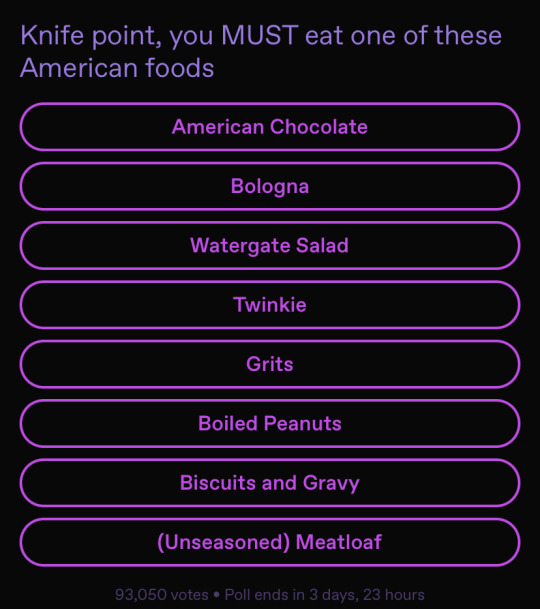
American Chocolate tastes different because of two factors: the majority of our cacao comes from South America unlike Europe which generally imports from Africa (moving product farther costs more money). Also, American chocolate is only required to have 10% cacao as opposed to Europe’s 20% (using less cacao and supplementing with readily available sweeteners like corn syrup costs less money). In fact, the very first American Chocolate company (Baker Chocolate Company) was so aware of how much less wealthy the early US was than Europe’s established market for chocolate, that their bars came with a money back guarantee for anyone who was disappointed with the sweets. The current financial situation in the US is well known to the rest of the world- of course we still make and eat cheap chocolate, the bones of our country are exploitation. Also, the dairy content is lower in American chocolates which makes them more shelf stable. Shelf stable foods are important for communities living paycheck to paycheck who have money for a chocolate bar right now but won’t for their kid’s birthday in a week.
Bologna feels self explanatory to me. It’s made of literal scraps from the meat production industry that are then turned into a “sausage” and cured to give the product more longevity. I like fried bologna because it was cheaper for my dad’s parents when he was a kid. My dad likes bologna for the same reason.
Watergate Salad is made of shelf stable ingredients. Many desserts require eggs or dairy that can be expensive and expire quickly. Those desserts then get stale if they aren’t eaten immediately. Canned fruits, pistachio pudding mix, and cool whip (which is hydrogenated oil and very little dairy) will all keep for a while. You can buy them in bulk and put them in your cabinets or freezer until you want to use them and then the salad itself will keep in the fridge. See again the importance of shelf stable foods to impoverished communities.
Twinkies are cheap and go stale slowly. See again the importance of shelf stable foods in impoverished communities.
Grits, Boiled Peanuts, and Biscuits and Gravy are all southern comfort food staples. I was born and raised in north Georgia, it’s very important to me to note that almost all southern food was co-opted from freed slaves by poor rural white folk in the south. Plain grits can be deeply unappetizing but they are cheap and self stable. You can add butter and salt or even seasoned meat and veggies. Grits are rarely a whole meal all to themselves and when they are you add some cheese or salt at the very least. George Washington Carver (a black man many people outside of Georgia should acquaint themselves with at least a little better) turned peanuts into a massive cash crop in Georgia because they are nitrogen fixing! They replace the nitrogen other cash crops (like cotton and tobacco) take out of the soil. In order for your fields to stay viable, you have to plant something like this every once in a while, so most farmers had peanuts themselves or had a neighbor growing peanuts. Boiling them is a quick, easy way to get salt on the nuts themselves. The water soaks through the shells and seasons and softens the nuts. Water is free and peanuts will keep until the fats start to go south, no wonder they picked up popularity among rural folk and travelers alike. Biscuits and gravy are another scrap food. A good sausage gravy is made of leftover sausage and southern biscuits are a savory, buttery carb that is filling and gives you energy you need somewhere like a farm. The negative stereotypes of the south are pervasive and often rooted in racism. Find someone whose grandma has been making these foods her whole life before you form an opinion.
Meatloaf is seasoned more often than not. Like. Sorry you ate meatloaf that wasn’t salted. Anyway, meatloaf is another scrap food! Meat scraps are ground up and then formed into a loaf. Most people put tomato sauce or ketchup on it. Canned tomato products are, you guessed it, shelf stable, and can also be canned at home fairly safely.
The United States at large is not ignorant of the world around it. We are aware that other foods exist. Either we are choosing to eat these or our financial situations are backing us into corners. This is all without even touching upon the prevalence of food deserts in low-income, minority communities in the US. If you’re aware of all this and you really just want to critique the wealth disparity in the US, punch up. Go after the guys with money, not the food that the rest of us find joy in making out of the scraps. Also, making fun of the British is always punching up. Maybe if you had caused fewer wealth disparities that directly impacted the food eaten in other countries, we would be nicer about yours.
#I wrote all this on mobile#so i couldn't link sources#but google is free#american food#american food poll#biscuits and gravy#american chocolate#bologna#watergate salad#twinkies#grits#boiled peanuts#meatloaf#long post
175 notes
·
View notes
Text
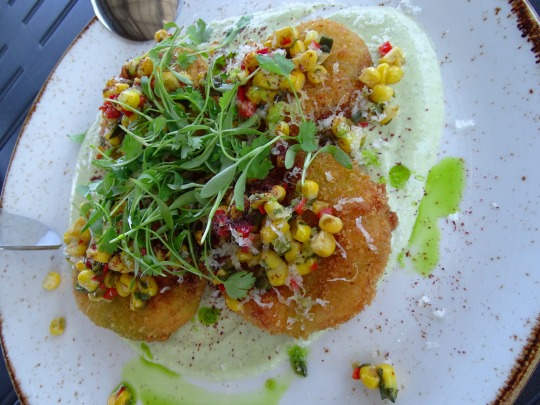
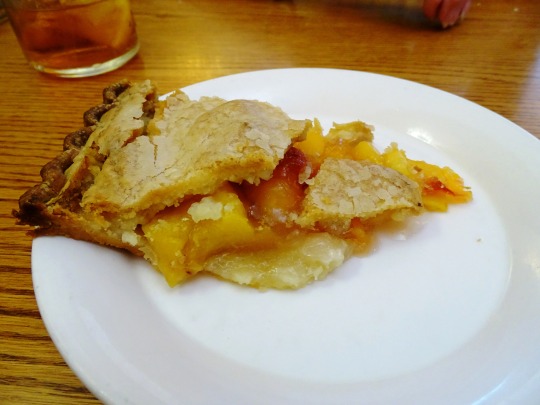

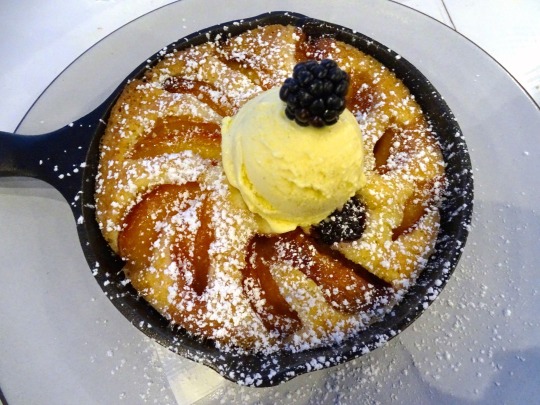
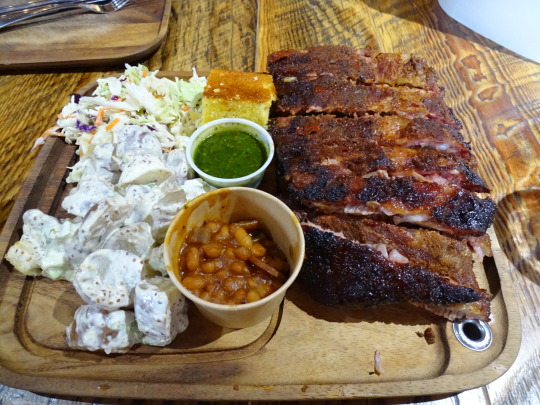
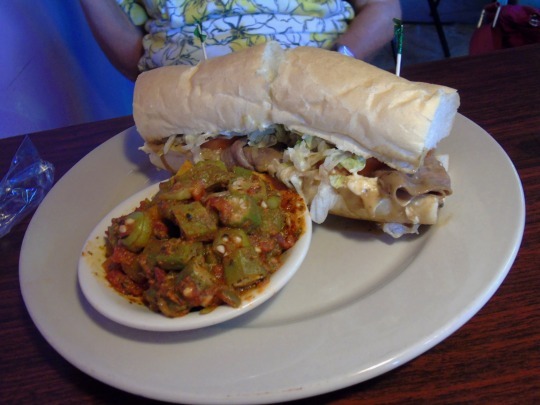

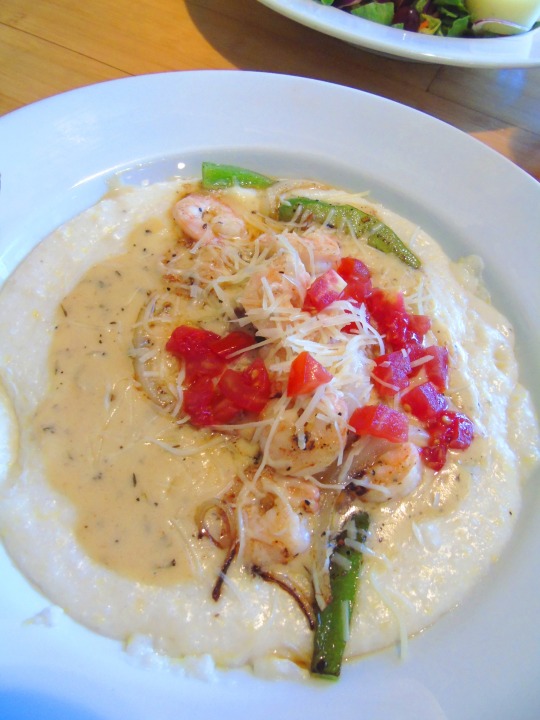



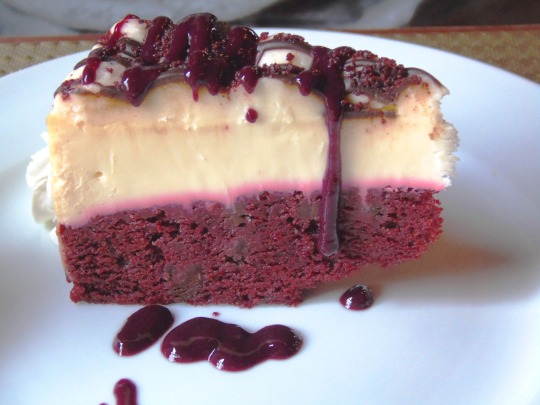

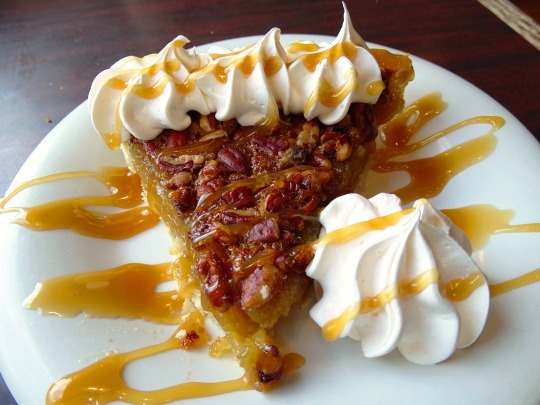
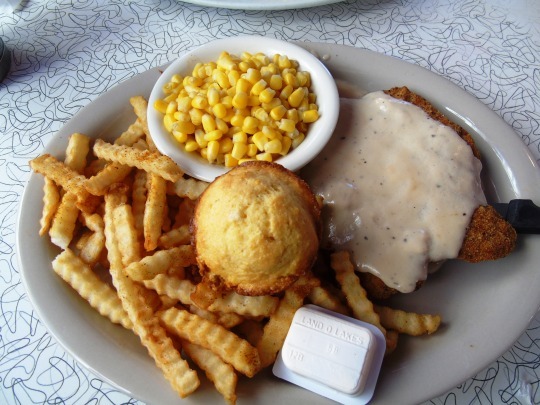
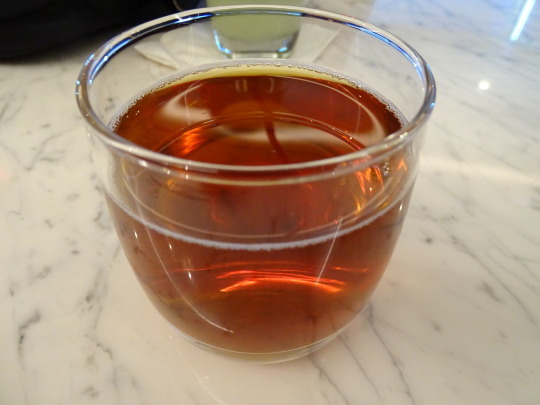
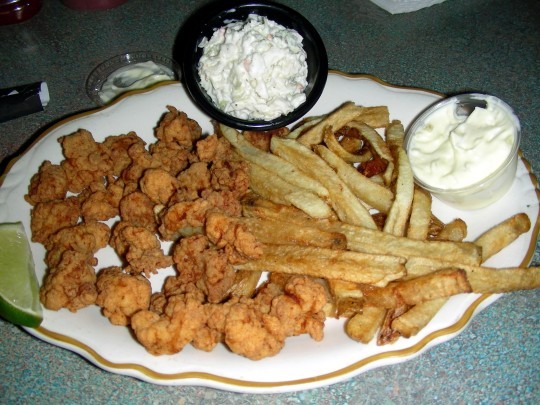
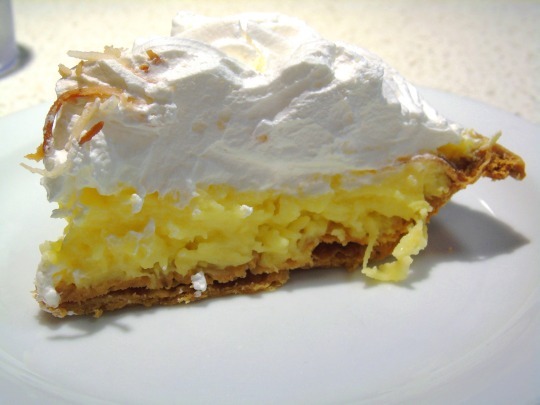
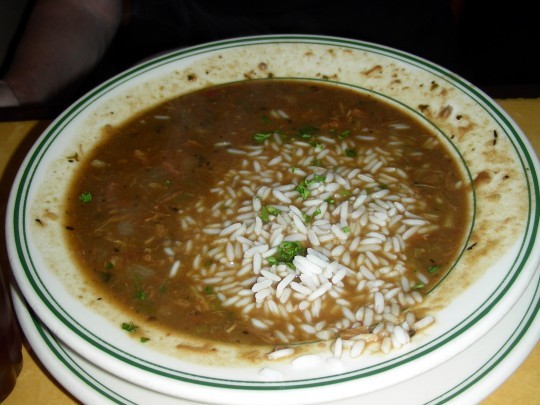
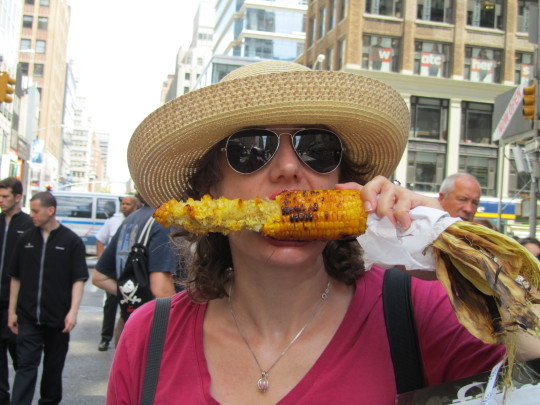
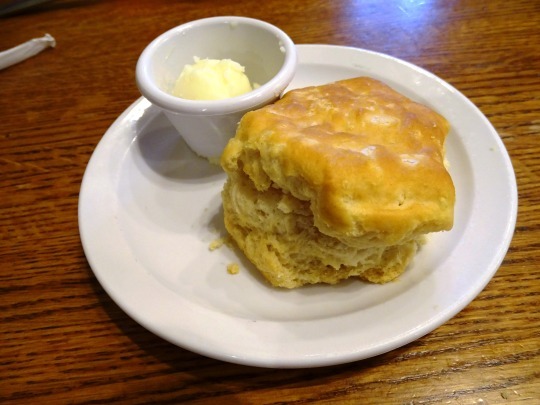
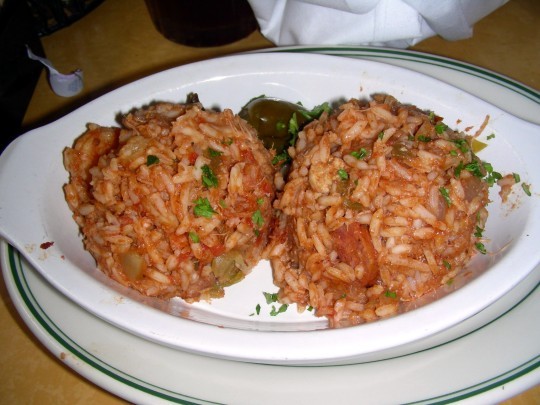
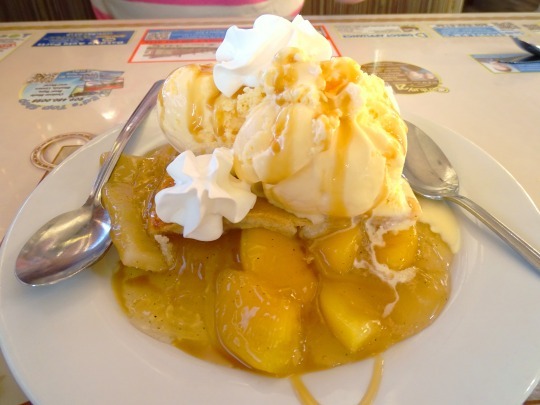
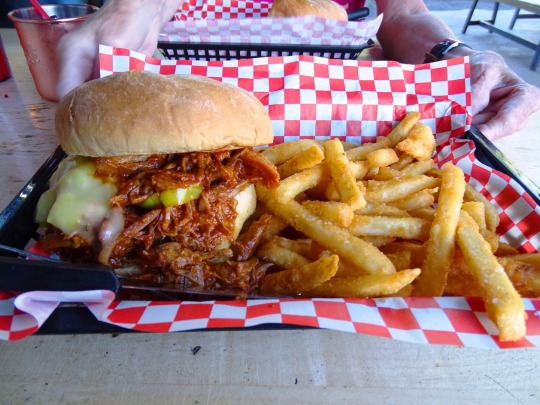

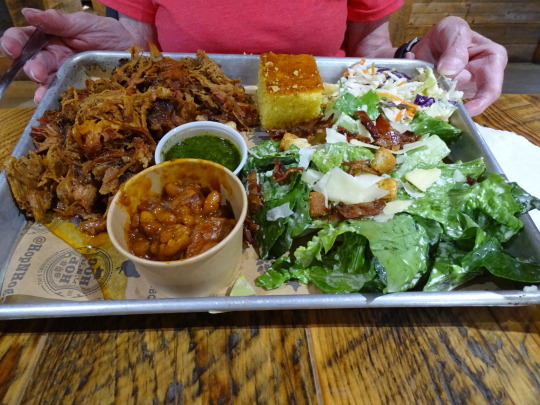

Southern Food Heritage Day
Every year, Southern Food Heritage Day is celebrated on October 11. The Southern Food & Beverage Museum celebrates the culturally rich and delicious food of the Southern States in America. The cuisine deserves to be recognized and celebrated officially because it is a testament to American history and legacy. Southern food also represents the essence of America — the coming together of a variety of people from all over the world, each bringing with themselves their own ingredients and recipes to create a unique cuisine. Iced tea, pickled shrimps, and fried chicken are some of the most loved Southern foods throughout history. Along with the cuisine, the day also celebrates the racial and ethnic diversity in America.
History of Southern Food Heritage Day
Southern Food Heritage Day celebrates the best that Southern food and beverages have to offer. The South’s cuisine in America can be found in the historical regional culinary form of states generally south of the Mason-Dixon line dividing Pennsylvania and Delaware from Maryland, along the Ohio River, and extending west to southern Missouri, Oklahoma, and Texas. The most notable influences on Southern cuisine are African, English, Scottish, Irish, German, French and Native American.
The food of the American South displays a unique blend of cultures and culinary traditions. The Native Americans, Spanish, French, and British have contributed to the development of Southern food, with recipes and dishes from their own cultures. Food items such as squash, tomatoes, corn, as well as certain cooking practices such as deep pit barbecuing, were introduced by south-eastern Native American tribes such as the Caddo, Choctaw, and Seminole. Many foods derived from sugar, flour, milk, and eggs have European roots. Black-eyed peas, okra, rice, eggplant, sesame seed, sorghum, and melons, along with spices, are of African origin.
Southern food can be further divided into categories: ‘Soul food’ is heavily influenced by African cooking traditions that are full of greens and vegetables, rice, and nuts such as peanuts. Okra and collard greens are also considered Soul Food, along with thick stews. ‘Creole food’ has a French flair, while ‘Cajun cuisine’ reflects the culinary traditions of immigrants from Canada. ‘Lowcountry’ cuisine features a lot of seafood and rice, while the food of the Appalachians is mostly preserved meats and vegetables. Southern food is partial to corn, thanks to the Native American influence.
Southern Food Heritage Day timeline
1860
Southern Diet Expands
Following the emancipation from slavery, the Southern diet becomes versatile.
1916
The Great Migration
African Americans travel from rural communities in the South to large cities in the North and West — they carry their cuisine with them.
1940s
Southern Foods in Restaurants
Southern foods start appearing on restaurant menus and appeal to a diverse clientele.
1964
Soul Food
This term, describing everyday Southern food, first appears in print.
Southern Food Heritage Day FAQs
What is the difference between Southern food and soul food?
The difference between soul food and Southern food is rooted more in class than race, and what families were able to afford to put on the table.
What is a typical Southern meal?
A traditional Southern meal is pan-fried chicken, field peas, greens, mashed potatoes, cornbread or corn pone, sweet tea, and a pie for dessert.
Why is Southern food so unhealthy?
The Southern diet is commonly high in processed meats, which are high in salt and in nitrates, which are in turn linked to heart risk. The high sugar content of the diet may also lead to negative effects, like insulin resistance and inflammation.
How To Celebrate Southern Food Heritage Day
Organize a cook-off: Gather all your friends and organize a cook-off on Southern Food Heritage Day. Revive old recipes or add a twist to create something new.
Go out for a meal: Enjoy the best of Southern foods at your favorite Southern foods restaurant. Don’t forget to enjoy the classics like fried chicken, hush pies, and pies.
Set up a barbecue: Barbecues are an integral part of the Southern food heritage. It is also one of the most popular styles of cooking. Barbecue your favorite meats and vegetables, and serve them with sauces and seasonings.
5 Facts About Southern Foods That Will Blow Your Mind
Redeye gravy has a unique recipe: Redeye gravy is made with pan drippings and leftover coffee.
It is more calorie-dense: Southern fried chicken breast typically has more than 400 calories in an ounce.
Peanut butter is an essential: Half the annual crop of peanuts is used to make peanut butter.
Collard green has been around forever: It’s been a part of our diet for more than 2,000 years.
Black-eyed peas are also good luck charms: It is believed that black-eyed peas bring good luck on New Year’s Day.
Why We Love Southern Food Heritage Day
A day to indulge: You cannot celebrate Southern Food Heritage Day without enjoying a hearty meal of your favorite foods. This is truly a day of indulgence!
Try something new: The best thing about Southern food is that it has something for everyone. Use this day to try a new food item or the cuisine of Southern heritage. Who knows, you might just discover your next favorite dish!
It is historically significant: Southern foods have a rich cultural and historical significance. Learn more about the origins of your favorite foods on Southern Food Heritage Day.
Source
#Peach Blackberry Cobbler#Peach Pie#Fried Chicken Sandwich#ice tea#Fried Chicken#collard green#Okra stew#Southern Food Heritage Day#USA#soul food#original photography#travel#vacation#restaurant#SouthernFoodHeritageDay#Coconut Cake#Shrimp and Grits#Hot Sausage Po'Boy#candied yam#Florida Gator Tail#Gumbo#Jambalaya#Pecan Pie#Chicken Fried#corn cob#Baby Back Ribs#11 October
7 notes
·
View notes
Text
Cascarilla & Efun In Your Practice + Their Uses

To day in this post I want to speak on spiritual Earth, things that are made from the earth like clay, shell, this form is used different ways. This chalk is an good tool to have in your practice.
It comes from the bark of the Croton elutaria tree that is found in the Caribbean and places like South America. Also is found in traditions of western Africa.


The concept of of this is in all West African diasporic practices including Hoodoo, Vodun/Voodoo, Santeria, Candomblé, Umbanda, Palo, and others. The word 'efun' is Yoruba translates in english meaning ‘chalk.’ In the tradition like Candomblé, efun is a ritual to initiate’s where the head and body is shaved and then decorated with tribal circles or dots (as seen above) useing chalk that was made from white clay, eggshells, or limestone powder. Some practices even use it to make a cross on there arms or on the bottom of their feet before a ritual bath.
Cascarilla & Efun: Sacred White Earth. Over time after useing the bark, other African religions such as Santeria or even in hoodoo and others in the US started using crushed powder egg shells. These were easier to get.

Cascarilla: ☝️Made from white eggshells, particularly from a Black Hen.

Efun: ☝️Efun is a white chalk that is comprised of ground snail shell and white clay.
What's Are They Really Used For. It is used for a offering Butt NOT a food offering, but an offering to deities of White meaning a of high elevated energies. (God) for example. In Africa it would be to Obatala and other high level good energies.
It's used for magical writings, painting the body during rituals, and as a medicine. In the Bantu system you have 'zumbi' other African practices like Vodou uses Zombi. (Snake deity) Or the God in the Heavens and God on earth like Nyambe/Nzambe.
("A little fact the majority of the Bantu people like others in Africa were and still are Muslim and the small percentage Christian")
Cascarilla Powder: The can be sprinkle anywhere to ward off negative energy: your home, altar, bedroom & your body. Add it to your protection powder. It’s also good to used in bath & washes, even in your divinations. I can tell you it has many uses.
Cascarilla Chalk: It can be used to make sacred symbols, magickal sigils, or veve’s and definition. (Sigils used in different Vodun/Voodoo practices). Cascarilla chalk can also be used to mark boundaries for sacred space sites or decorate sacred items.
Modern Witchcraft Uses: the power of eggshell powder has become prominent among other traditions, including Wicca. However, most non-West African diasporic traditions refer to Cascarilla simply as eggshell powder.
For Cleaning: If you want to cleanse yourself, make a mix of Florida Water & Cascarilla for a simple yet effective spiritual bath simple yet effective. (You can also add dry ingredients to it) You can also add it to a premade floor wash like the Chinese wash.
#Cascarilla uses#Efun uses#African powders#Protection chalk#Powdered chalk#spiritual#Spiritual chalk#southern hoodoo#rootwork#like and/or reblog!#google search#conjuring#traditional hoodoo#follow my blog#Voodoo#IFA#Magic powder#ask me questions#ask me anything#contact me#Teaching magic#rootwork questions#traditional rootwork#black spirituality#southern rootwork#southern conjure#new orleans voodoo
28 notes
·
View notes
Text
my dear
a/n: this ones for the anon who wanted me to elaborate on this fic so here it is! i highly recommend you read the previous fic before diving into this one, just so you get the idea. oh and this is also highly unedited....anywhos, enjoy some singer!reader x danny <3
masterlist



I swear I'll always give my best, no pretending Give you breakfast in bed every morning There ain't no answer to this complex question I just keep falling for you every day
another hotel, another city. another room, another unfamiliar setting. but this time you weren't alone. you lean against the smooth leather headboard, sheets draped lightly around your body. you were watching the scenery outside the window when the doorbell rings, and before you could even think about moving, an 'i'll get it!' echoes from the bathroom.
"i'll take this" you hear from the door, and soon you see daniel pushing in the squeaky-wheeled cart filled with food. he was wrapped in a bathrobe, hair still standing from last night's restful sleep.
"breakfast, m'lady."
you smile softly, crawling to the edge of the bed. daniel sits across from you, handing you your cup of coffee. you both eat in comfortable silence, exchanging a portion of your pancakes for some of his french toast.
"when's the next show?" daniel asks with a mouthful of fruit.
you sip on your coffee before answering, "i've got two weeks off before the european leg."
"two weeks eh?"
"yeah," you feed him a banana from your plate, "i'm spending a week in nashville with blake to finish up a couple of tunes. i'm free on the second week."
"how about cota?" he asks almost too casually.
you hum, slicing the pancakes into smaller pieces. circuit of the americas. the texas weekend. one of daniel's favourite races of the year.
"c'mon love, you know you love a good trip to texas. think about the barbecue! the people, the music." he nudges you from across the table.
daniel is glad that it wasn't an immediate no, and it hasn't been since the sponsorship event. you've accompanied him to a handful of other events at this point, and he's showed up at your shows a couple of times too.
even the fans were getting hints. the mclaren admin had been posting pictures of these said events, with you standing close to daniel; and you had sometimes given them the soft launch on instagram - the subtle hand in your posts, or the occasional picture of brunch for two.
you were starting to give him commitment, starting to open your heart up to the australian; and although it was terrifying, you were absolutely enjoying the free fall.
"let me think about it?" you asked daniel, even though you didn't have to think twice to know the answer.
he grins at you, "that's better than a no."
-
the both of you spent your last day roaming the streets of south italy - gelato cone in hand as you walked down the cobbled path. when evening rolls around, you both walk to a quiet restaurant near the hotel and ordered dinner. you look up from your menu, watching daniel quietly as he analyses the description of each dish; his brows furrowed together as he pretends to understand the ingredients listed in italian. you clear your throat to get his attention.
"so, about texas..." you say with your hands cupping your chin as you lean forward on your elbows. daniel looks up at you with his eyes glistening.
"it's a yes from me."
"YES!" he shouts a little too loudly, apologising to the patrons near him as he closes the menu dramatically. he leans over the table and kisses your forehead softly, "thank you."
-
"you ready?" daniel closes the door to the rented mclaren, intertwining his fingers with yours. you nod, and the both of you make your way into the paddock. it felt almost like a red carpet event - lights flashing, photographers calling out your name. they were having an absolute field day with your presence.
"y/n! y/n! over here!"
"are you and daniel together?"
"daniel! is this your girlfriend?"
you make your way through, smiling shyly for the cameras as daniel leads the both of you through the small crowd. he's eventually stopped by some fans, and releases the grip that he had on your hand. you take a couple steps forward, allowing his beloved fans to have some one on one time with him.
but its not long before a young girl came up to you, holding an orange number '3' cap and a black sharpie; the front of it already signed by daniel.
"i'm a really big fan, could i get an autograph?" you look at the wide-eyed girl and smiled at her, gladly taking the marker and signing onto it. she runs off giddily, shouting to her parents about the signatures she just got.
the hand on the small of your back brings you back to reality, daniel standing right next to you to guide you to the hospitality building. it's behind the glass doors where you find a different kind of buzz - various team members getting their breakfast and having meetings. you wave to a couple of people you recognised from past events, before you heard someone call out to daniel. his hand rests on your back again, pointing to the table in the far corner where lando and zak were sitting.
"tell me you've snagged the girl, DR?" zak asks. daniel looks at you then back at zak and smiles, "i'm almost there i think."
you follow daniel back outside to the paddock, where a few of the drivers and their girlfriends had formed a small circle. they were talking and catching up with one another while you stood back, not being too familiar with everyone. but someone, you recognised as george russell's girlfriend, came up to you.
"y/n, right?" she asks and you nod.
"i'm carmen, george's girlfriend. daniel spoke about you before at dinner." you shook her outstretched hand.
she nudged you after, "big fan of your music by the way."
you blushed, "thank you, it's really nice to meet all of you."
"it's really nice to finally meet you! if ever daniel annoys you, just come by mercedes, you're always welcome." she jokes, and daniel sends her a playful glare which makes you laugh.
and for a moment, everything seemed to be going okay, amazing, in fact. until you made your way to the garage and started watching the race.
fuck. shit. god dammit.
those three words echoed throughout the garage.
you watched daniel's car spin out on screen, after being clipped in the back by another competitor. your arm was wrapped around your own body, picking at the fabric of your shirt. michael, daniel's physio, turns to you to try to give you a reassuring look; but nothing was going to calm you until you see him, hear him.
"daniel, do you copy? is the car okay?"
if you could shoot daggers with your eyes, daniel's race engineer would've been stabbed by now. you watched on the screen as the cameras covered movement in the car, and daniel's voice echoed through the radios seconds later.
"i'm okay, car's fine."
you take a breath, gripping on to whatever you could to steady yourself. its more than a hot minute before daniel's car rolls into the garage, semi wrecked, and you're speechless as your eyes fixate on the australian. you watch as he climbs out of the car, going over to his race engineer, then michael; minutes feel like hours as you watched him talk, your eyes never leaving him. he scans the garage after his conversation, and he spots you.
no words shared, everything floating in both your minds as you lunged towards each other. he relaxes in your arms and so do you, nuzzling your head into the crook of his neck.
"fuck, i love you danny. i'm so glad you're okay."
he chuckles, and you can feel it vibrate through his body.
"i fucking love you too, y/n."
taglist: @primadonnasdream @dr3lover @chicadelapartamento512-blog @thebagginsofbaggend @d0ntjudgemy50shades @cowspew @justthatgirlxox @ggaslyp1 @fromthedeskofjoii @lorenakaspersen @words-4u @o0itsjustme0o @gulsolsikke @enjoymyloves @rmaddens-blog @care2703 @katcontrreras @tattered-tales @piceous21 @kyomihann @sgkophie @idkiwantchocolate @ricc3rodeo @organasith @anthonykatebridgerton @icecoldtires @vamossainz55 @ophcelia @dudde-44 @ladyf1 @kissatelier @leclerc16s @nmw-am @dan3avocado @ally4and33 @amsofftrack
#daniel ricciardo x reader#daniel ricciardo#daniel ricciardo fic#formula 1 one shot#formula 1#formula 1 fanfiction#formula one fanfiction#formula 1 fic#formula1
172 notes
·
View notes
Text
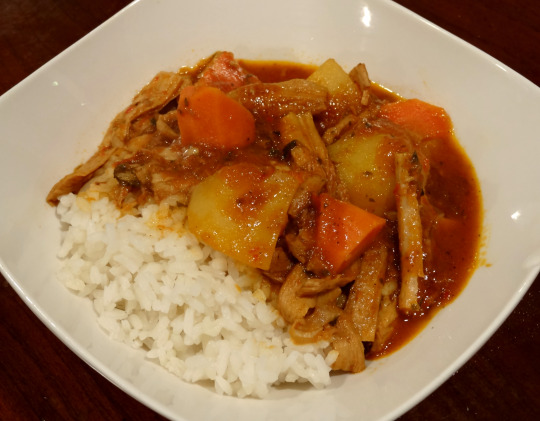
[ID: A bowl full of rice and a reddish, saucy stew with carrots, potatoes, and shredded chicken. End ID]
Vegan pollo guisado (Puerto Rican chicken stew)
Pollo guisado, a popular dish in Central and South America and the Caribbean, combines marinated and braised chicken with potatoes, carrots, and green olives in a tomato-based broth. This Puerto Rican version uses a recaito of onion, garlic, aji dulce peppers, and culantro to add savor and depth to the dish, while sazón lends spice and color.
Recipe under the cut!
Patreon | Tip jar
Ingredients:
For the chicken:
About 150g sườn non chay, or 300g ready-made vegetarian chicken substitute
Water plus 2 tsp vegetarian chicken stock from concentrate (if using sườn non chay or other dried meat substitute)
1 Tbsp vegetable oil (if not using sườn non chay)
1 Tbsp sazón
1 tsp garlic powder
1 teaspoon salt
1/4 tsp black pepper
1/4 tsp dried oregano
Sườn non chay ('vegetarian ribs') is a Vietnamese soy- and wheat-based meat replacement. It may be found in bags online or at your local Asian grocery–the bags will be labelled “sườn non chay” as well as “vegan meat slice,” “textured soy bean protein,” “vegetarian food,” or “vegan food.” I like it for its versatility and stringy texture, but you can use any vegetarian chicken substitute you have on hand, or even omit the chicken and increase the amount of carrot and potato.
For the recaito:
1/2 large white onion, chopped
1/2 head garlic, peeled and chopped
2.5 oz / 70g (5 medium) aji dulce peppers, chopped
1 oz / 28g (a few slices) mixed bell peppers, chopped
About 18 (1.5oz / 43g) culantro leaves, ends removed and chopped
1 small bunch cilantro, leaves removed
This basic mixture of peppers, aromatics, and herbs is a common base for many Latin American dishes, though its exact composition varies according to region and personal preference. Some would call such a mixture a "sofrito"—others will insist that it is a "recaito" until the tomato is added, at which point it becomes "sofrito."
Culantro is an herb related to cilantro but somewhat sharper in taste. It can be found at a Latin American grocery, or an Asian grocery that sells Vietnamese produce (where it will be called "sawtooth herb" or "ngo gai"). You may substitute more cilantro if necessary.
For the dish:
Extra virgin olive oil
1 Tbsp sazón, divided
1 tsp garlic power
1 bay leaf
1/4 cup recaito
4-5 tomatoes, diced (or 1 8oz-can tomato sauce)
1/4 cup Spanish olives
1/2 pound (2 medium) potatoes, peeled and diced into large chunks
2 medium carrots, cubed
2-3 cups vegetable stock, or vegetarian chicken broth from concentrate
2 sprigs fresh oregano, or 1/2 tsp dried oregano
Salt and ground black pepper, to taste
Instructions:
For the recaito:
1. Mash all ingredients in a mortar and pestle until a rough paste forms.
You may also use a food processor: process the onions for a few pulses, then add garlic and peppers and pulse again. Finally, process the culantro and cilantro leaves, in batches if necessary, until sofrito is the consistency of apple sauce.
For the chicken:
1. If using sườn non chay: whisk vegetarian chicken stock concentrate and spices (sazón, garlic powder, salt, black pepper, and oregano) into enough hot water to cover the sườn non chay in a cassrole dish or other wide, flat vessel. Soak sườn non chay for 10 minutes, until tender, then tear into small strips. In a large pot, simmer sườn non chay in their soaking liquid until the liquid has completely evaporated.
2. If using another chicken substitute: mix all marinade ingredients in a large bowl. Add chicken substitute and mix to coat. Refrigerate and marinate for half an hour while you prepare the other ingredients, or overnight. For the recaito:
1. Mash all ingredients in a mortar and pestle until a rough paste forms.
You may also use a food processor: process the onions for a few pulses, then add garlic and peppers and pulse again. Finally, process the culantro and cilantro leaves, in batches if necessary, until sofrito is the consistency of apple sauce. For the dish:
1. Heat 1/2 cm olive oil in a large pot on medium. Fry chicken, turning as necessary, until golden brown on all sides. Set aside.
2. Mix sazón, garlic powder, and black pepper with just enough water to form a thick paste. In the same pot you used to fry the chicken, fry the bay leaf and most of the spice mixture until water has evaporated.
3. Add the recaito and sauté for three minutes, until fragrant. Add tomatoes and allow to cook until mostly dry.
4. Add olives, potatoes, and carrots and stir to combine. Allow to fry for another couple minutes.
5. Add vegetable or chicken stock and remaining spice mixture. Raise heat to bring to a boil, then lower heat to a simmer. Cook until potatoes and carrots are almost tender. Add chicken and heat through.
Serve hot, over rice.
#recipes#Puerto Rican#vegan recipes#vegetarian recipes#carrots#potatoes#olives#chicken#culantro#stew#cooking#gluten free#depending on the chicken sub you use
105 notes
·
View notes
Note
You’ve probably gone over this before but tumblr’s search engine sucks butt. So, what would each culture’s staple crops and livestock (for both meat and byproducts) be? How much would globalization come into play, like how irl potatoes are originally from South America but have become one of the most important staple foods across the world?
Staple crops and livestock vary throughout the Provinces due to climate and geography, though trade over the centuries has meant that ingredients like saltrice from Morrowind and honey from Skyrim are in constant circulation around the continent. Nonetheless, here are some uniquely local ingredients you'll find across Tamriel.
Altmer
Summerset's temperate climate makes it the ideal place to grow all sorts of exotic fruit, especially stone fruit. From peaches to lychees, nectarines to cherries, Summerset produces the largest quantities of these fruits (with the trade embargo around the Great War and Dragon Crisis making them an extremely sought-after prize). And don't forget the wine! Summerset is also famed for its gorgeous vineyards and even more gorgeous wines. However, juicy and flavourful grapes are beloved by almost anybody, making them a valuable staple crop too.
Livestock in Summerset is nothing particularly exciting. Merino sheep are farmed for their wool, which is a luxury export beloved by northern Provinces, while meat comes in the form of cattle and chickens. However, High Elves particularly love their wild-caught fish and herons, which are populous on their home island.
Argonians
Once again, fruit is a major export from Black Marsh, but the fertile (if hostile) region is home to some of Tamriel's best agricultural soil. From cocoa and coffee beans, saltrice and coconuts, to padan and banana leaves and more, you'll find all sorts of wonderful plant-based ingredients in Black Marsh. However, something that has gained in popularity following the Argonian diaspora has been palm wine, a potent alcoholic beverage.
As for livestock, you'll find bantam guar, guar lizards, various poultry, goats, and even farmed frogs and lizards to be popular. Sheep and cattle are far less popular due to the upkeep required for them to stay healthy in the swampy environment, making beef and mutton less popular and more expensive than in other Provinces.
Bosmer
The Bosmer are famed for their meat and animal byproducts, particularly from timber mammoths and sugar mammoths. Whether it's meat, pelts, or milk, these beasts are much beloved by the Wood Elves who take great care in rearing them.
Other popular exports from Valenwood include alcoholic beverages like rotmeth and jagga, as well as kopi luwak- a luxurious type of coffee made from beans found in civet cat excrement, thus making them Green Pact-friendly. And of course, Valenwood produces some of Tamriel's finest cocoa beans, mostly used for export. However, have you truly lived until you've tried salted sugar mammoth caramelised milk chocolate from Woodhearth?
Bretons
In High Rock, sheep and cattle are the most popular livestock to farm due to their versatility, with a constant demand for their meat, horns, skins, and milk. While it's nothing exciting, the animals in the region are usually grass-fed and free range, spanning acres of farmland (which can sometimes result in cultists and the like infringing upon the livelihood of livestock). Chickens, geese, turkeys, and ducks are also popular for their meat, down, and eggs, with High Rock producing some of Tamriel's best duck meat.
With regards to staple crops, wheat is a major export and features heavily in Breton cuisine, especially in bread.
Dunmer
The volcanic ash of Morrowind is key to its success in growing all manner of weird and wonderful crops. Market stalls across Vvardenfell and Blacklight bustle with sellers touting mushrooms of all kinds, saltrice, comberry, marshmerrow, hackle-lo, canis root, and much more, all of which are consumed locally as well as across Tamriel.
Regarding livestock, it should come as no surprise that the big money is in bug farming. Kwama mines produce cuttle, scuttle, scrib jelly, and kwama eggs, making them the backbone of Morrowind's mages and chefs alike. Nix-hounds and guar are raised both by town Dunmer and Ashlanders, while wild nix-ox is also popular for those who can afford it.
Imperials
Cyrodiil spans terrain from the snowy Jerall Mountains to the swamps of Blackwood. As a result, the Province is relatively self-sufficient in that it produces the bulk of its own consumption, from livestock to greens. Speaking of greens, battaglir, a type of weed, is a staple in the Imperial diet, making wild-foraged and farmed battaglir a key crop in the region. Like Summerset, Cyrodiil is also famed for itswines, and is proud of its unique grapes of every size, flavour, and colour (including ones that taste like cotton candy).
Livestock in Cyrodiil is about as generic as can be: cows, sheep, goats, poultry, and horses. While meat is a staple part of the Imperial diet, milk is also important as it is used to make the cream and cheeses so prized by the Province.
Khajiit
What don't the Khajiit grow or rear? From Southern Elsweyr's rich moon sugar and rice paddies to the North's edible cacti and tea, the Province is full of exotic and scrumptious delights that are highly prized across Tamriel. Ingredients are valuable both raw and processed, and form the backbone of the Khajiiti economy. Samar Pekoe tea, for example, is wild-harvested from caves and is beloved by tea aficionados across the continent, and fetches a hefty price for its rarity. Pellitine cacao and coffee beans are also a staple in any self-respecting chef's kitchen.
In terms of livestock, you'll find guar, poultry, beef, and goat to be popular, as well as wild game like jerboas, terror birds, antelope, and addaxes. Game meat can often be purchased from Bandaari nomads, who hunt the animals themselves. Whether fresh or dried into jerky, who doesn't want some moon sugar-cured addax jerky for the road?
Nords
Foreigners in Skyrim are often shocked by the range of produce we're capable of producing in our cold and often inhospitable lands. Fish and horker are consumed in great amounts locally, as well as being one of the Province's major exports. Goat from the Reach, cattle from Whiterun, and honey from the Rift are always in high demand.
Apples and jazbay grapes are probably the most valuable crops in Skyrim, followed by wheat and other fruits and vegetables. The former two are used in cider and wine, both of which are valued across the Provinces.
Orcs
Wrothgarian Orcs differ from Betnikh Orcs who differ from Wood Orcs and so on... so in this case, it really varies. For Wrothgarian Orsimer, echatere is the main source of meat and milk, while in Betnikh it's fish, and in Valenwood, timber mammoth. All these groups also enjoy game, from rabbit and wolf to pheasant and venison, which features heavily in regional Orcish cuisine. Wild honey from Betnikh is also another notable animal product that bears mention here.
In terms of crops, there aren't many of note aside from valuable herbs and spices. Frost mirriam, which is also loved by alchemists, and wrathberries, known for their violently bitter taste unless prepared correctly, are two of the most important plants you'll find for sale at any stronghold.
Redguards
I've said it before and I'll say it again: goat, goat, and more goat. Unless you're a coastal Redguard with access to seafood, it's likely that your main source of meat and milk will come from goats. Whether it's feta or kebabs, it's almost always goat meat, as they wander all through Hammerfell like they own the place. However, Redguards are also renowned for breeding horses, and the uh... faulty ones are generally turned into food. Spiced horse blood sausage and spreadable horse 'nduja are a staple in households across Hammerfell.
With staple crops, you'll find that corn, coconuts, palm fruit and oil, bananas, coffee, cinnamon and other spices, and cocoa are plentiful. These are all consumed in great amounts within the Province, but are also highly prized across Tamriel.
77 notes
·
View notes
Text
So, MCD right? I'm working on some world build aspects that change the state of the redesigns I do. Here's kind of like the skeleton of my world building.
[Regions]
Different villages have different country inspiration, Regions are just continents.
Ru'aun - Werewolves/Dire Wolves, (European). A general melting pot of diversity, also where the best education is in the magick scholar/history/art way.
Tu'la - Asia Inspired (ALL parts of Asia in the different parts of Tu'la) . Felines, Foxes, Mythological Creatures (Asia). Deals with Ghosts, Monsters, Magick issues. Magick powerhouses
Gal'ruk - Chain of islands, Fish People, Fishing/Trading Powerhouse. (Polynesian Inspiried)
Pa'lotal - A mixture of Central and South America. (WE NEED THE INGREDIENTS FOR NON EUROCENTRIC FOODS.) South American mythology creatures exist. Plant people who can grow plants whenever on themselves or on the people.
Culinary powerhouse Also underground extracts like poisons.
Miyagi - Candyland. Any fashion goes, it's usually made out of candy esque spiel. Known for their magic foods/monsters/materials. (KC studied here for her Magick!).
(This was inspired by the exploding ice cream baker! Thought it'd be fun to have a region where everything was like this.)
Fu'kui - African continent based area. It has the advanced minerals/technology. They're filled with dwarves, halflings, rabbit people, other African mythology creatures.
Other species in Fu'kui include
Grootslang - Powerful cave snake with caves filled with diamonds. (Would have been a fun MC mob)
Impundulu - Lightning Bird (They can shapeshift into lightning birds)
Popobawa - Human by day, One eyed demon at night. The nightmare causer
Other species in Pa'lotal
Jarjacha
Maricoxi
Encantado
And, we ended up wanting to make a new relic. One based off the Lord who died and was generally forgotten, I think despite their naming the village their influence was genuinely lost. I figured it was such a waste for the name Phoenix Drop to be built up then have it fall flat with 0 payoff. It's still a WIP!
Phoenix Drop: An ancient relic that allows you to reverse damages to a target so it's back in it's prime. Once used, it disappears for 100 years unless the user bonds with it. Once bonded, the user gains a pair of wings/feathers that allow you to replicate the properties. Generally, when bonded misfortune befalls the user as people tend to hunt them down for their winged properties.
94 notes
·
View notes
Text
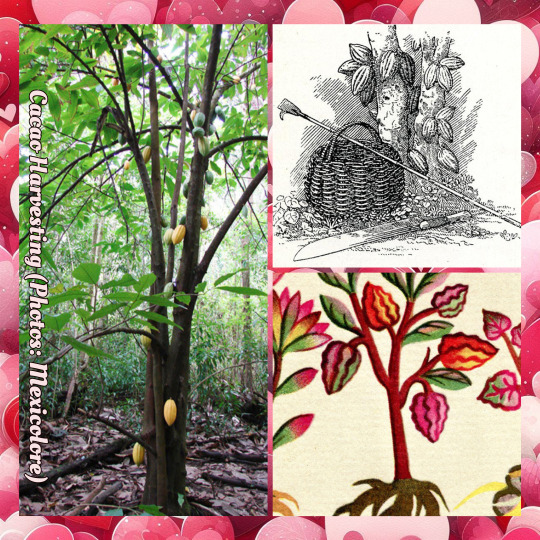

Giving chocolates is a way to show your love on Valentines Day. Human beings have been in love with chocolate and the Cacao tree (Theobroma cacao) for thousands of years, and today we will learn about the romance of culture and chocolate.
Although Cacao is most famously associated with Mesoamerican cultures, genetic studies indicate that Cacao was domesticated by indigenous Americans around 5,300 years ago in the Upper Amazon region. From there, Cacao cultivation spread north to Mexico. The Cacao fruit pulp was more commonly consumed in South America in Pre Columbian times while the Mesoamericans invented the technique of fermentation and roasting to utilise the Cacao nibs.
Archaeological evidence, such as chemical residues on ancient pottery shards, pinpoints the first use of Cacao drinks in Mesoamerica around 1600 BCE. By the time of the Classical Mayan civilization (250-900 CE), ground cacao nibs were mixed with water and spices by careful pouring between vessels to make a nourishing and invigorating hot drink which was consumed by people of all social classes. In the later Mexica (Aztec) civilization, cold cacao drink or xocoatl (bitter water in Nahuatl) exquisitely flavoured with flowers, fruits, chillies, and spices was reserved for the elite and ceremonial occasions. Cacao seeds were used as a form of currency for trade and barter during the Mexica Empire.
After the conquest of the Mexica Empire by Spain in 1521, cacao was one of the many new plant-based foods brought to Europe. In Spain, the locals of Andalusia experimented with the spicy xocoatl by adding cane sugar and dairy ingredients. It is said that drinking chocolate was so universally popular from the 17th century to the late 19th century that it prevented coffee from becoming mainstream in Spanish culture. Drinking chocolate caught on in the rest of Europe in the 1600’s but it was not until the mid 19th century that innovation in processing and chemistry allowed the invention of solid chocolate candies. Cadbury chocolate company is credited with marketing chocolates as a token of love for Valentines Day in 1868.
Chocolate in the modern world is not always a sweet story. Today, approximately 70% of the world’s cacao is produced in West African countries like Ghana and the Ivory Coast. Sadly, exploitative practices like child labour and enslavement are still rife in these countries’ Cacao farms. Chocolate lovers can help by buying Fair Trade certified chocolate products and other responsibly grown cacao products. Fortunately, cacao can be grown in sustainable agroforestry alongside native rainforest trees especially in Latin America. Cacao’s sacred and medicinal properties are experiencing a renaissance among “chocolate shamans” around the world who drawn upon indigenous knowledge to make the ethical production and mindful consumption of cacao a healing spiritual experience.
Humanity and Cacao have a long-lasting love that continues to evolve over time, and has the potential to benefit plants, people, and the planet. Ponder the storied history of Cacao if you indulge in chocolate this Valentines Day.
Image credits to Mexicolore
#katia plant scientist#botany#plant biology#plants#plant science#cacao#cacao tree#trees#economic botany#culture#cultural history#chocolate#drinking chocolate#spanish history#native american#mesoamerica#aztecs#mayans#mesoamericans#mexico#ceremonial cacao#shamans#fair trade#chocolates#food history#west africa#cacao nibs#cacao beans#aztec history#colonialism
9 notes
·
View notes
Text
the isekai thing where,
Hey this post is too long and i'm not fuckin editing down my stream of consciousness tumblr post because it's dumb anyway.
, because of weird inscrutable genre stuff, the protagonist often can't just be The Strongest Person In The World or like recruit all the strongest people into their party or learn magic or something, or use modern medicine to save lives or whatever, they need to also like. Be a business owner. and they can't just like- like, they always Invent Soap (Note: Soap existed already) or whatever, and to be fair, inventing the bessemer process is often a pretty good one.
but no they also need to be like, importing japanese cultural products (sometimes korean! when it's a korean one. duh.) to the fantasy world, which are universally beloved because obviously japanese cultural products are great and applicable everywhere. like, every medieval noble wants to wear a yukata. and like, they can never just have one business either, they have to do like 20 things and each member of their cast has their own subsidiary business (which lets you get rid of some of the cast members because theyre successfully doing their own thing, i guess). but like okay yknow. one of the ones they *always* want to do, because food is such a big thing for culture, is open a restaurant. and it's like, guys, the economics on this are insane.
(First off, this was prompted by the summer 'when a book is set in year A and written in year B and the author refers to X dollars, do they mean X dollars in year A or are they automatically translating to the equivalent year B monetary value' which presumably is talking about real life stuff)
but like dude, when these fuckin isekai protagonists open a fast food restaurant and they bill it as 'the genius idea is that we'll sell to the lower class and get a bigger market' like. first off, they had restaurants or similar equivalents back then. like, thats part of what the tavern was for. and the wealthy people could afford to just have chefs on retainer. but secondly, those peasants are not paying extra for your insanely expensive spices on your Japanese Ramen or Korean Fried Chicken In Medieval Europe. like the protagonist always has to find how some rare plant or monster part tastes exactly like the right ingredient they were missing and they're like, oh FINALLY i can eat some of the cuisine i've been missing. and then they open a restaurant.
and it's like no go back a second this shit was rare as hell you can't sell that to poor people. like dude that medieval milk soup (btw. Whats up with that. Max Miller made a video on one that was like, essentially the milk from your bowl of cereal where it was full of cinnamon and sugar. but he mentioned that there were actually savory milk soups with meat and vegetables in it, and he just isnt doing one of those. And that's like, obviously the more interesting one, and is the one you see in some of those isekai that makes you go What The Fuck Is That? Like for real what was in that. Whats up with the milk soup) was cheap as fuck. like the cows just make the milk. and like bread is bread. like the food isnt gonna be total dog shit, it's still fresh food, they have some herbs and spices just not *all* of the ones we have, the maillaird reaction still works the same. you got eggs, mushrooms, butter or animal fat. missing some veggies because you havent made contact with south america (although. i mean it's fantasy you can make it up. but they never make the thing they use to make the pseudo-japanese/korean food a super common ingredient because then it would already be in use and the protagonist wouldnt be like craving for a taste of home and then inventing a new cuisine and being super smart and innovative)
Anyway thats that but the other thing is it's insane when a story forgets to do the copper-silver-gold thing and peasants are spending like 20 gold pieces on some Fantasy Meat Skewers or w/e. like you find a treasure chest full of golden ingots and you're like holy shit we're rich but each ingot is only like a hundred sandwiches. (although admittedly i feel like copper still had to be like. pretty expensive back then right? like silver for sure, it seems insane for 10 copper coins to be worth a silver coin, but it also feels insane that you would buy a beer for multiple pieces of like metal that was taken out of the earth and refined from ore and melted into a coin. I guess they didnt have wiring so the value was probably lower)
the main thing though is why the hell are all the isekai protagonists opening like 7 small businesses. thats weird man. they should just be stabbing dragons or whatever why are they like opening a massage parlor. anyone can do that. the comparative advantage is horrible
3 notes
·
View notes